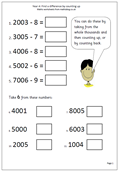 This page looks at the way money and coins can be used with helping to count on in tens. The questions become progressively more difficult and this would be most suitable for year 3 children as well as year 2 children who are confident with counting in tens.
This page looks at the way money and coins can be used with helping to count on in tens. The questions become progressively more difficult and this would be most suitable for year 3 children as well as year 2 children who are confident with counting in tens.
The first three questions look at adding 10p to a multiple of 10p and should be very straightforward. The second set look at adding 10p to any 2-digit number, which again should not prove too tricky.
The third set are more tricky as they require adding 10p to money represented in pounds,using the decimal point. Watch out for children who add a ‘p’ at the end so that both the pound and pence sign are showing. This, of course, is not necessary and is strictly incorr3ct – just the pound sign is sufficient.
The last set of questions looks at counting on in steps of 10p, but at this stage the counting does not go over the next 100 or next pound. This will be the next step.
